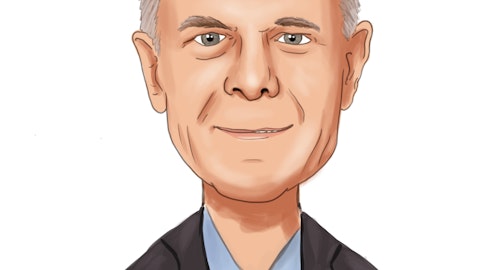These are–you know, we’re a small company but Dish is a big company and they have much bigger networks, so what you have to face, and I’ve seen this before at my time at IEC with USA Network and SyFy, where we had the biggest networks and we have the fastest treatment, or even in scripts with HDTV and Food, you get priority treatment when they’re very big like that.
We’re not as big as Disney and a lot of these other channel conflicts that Dish was going through, so we were able to sit down and really talk with Dish. Like we’d said, we’re been partners with them for 20 years, nobody wanted to go through what we were going through, so once we resolved it, then there was just the process of going through the sign-up again and getting all the slots right, and making sure we’re on the same channels as we were before. I have to say that it happened faster than I expected, even though it was a painfully long five, six months, but that was something that we were expecting and that we wanted to guide to. I can’t say enough again about the customers that are there and the team at Dish. We were all working towards the same strategy of finding a place that we both felt good about, and that’s what we were able to do.
Alex Fuhrman: Great, that’s really helpful, Tim. Thank you for that. I know it’s early to talk about numbers for ’23, but just as it relates to the sale-leaseback, what is that going to do to the numbers in aggregate as you consider the lease payments and presumably a reduction in debt-related interest expense?
Tim Peterman: Yes Alex, when you think about our business and our performance, this is like we’re at the tipping point, if you will. A year and a half ago, I talked about being EPS positive in Q4, and that is an important thing for 2023 as well. We first had to fix the revenue–first we had to fix the expense structure, then the customer file, then the revenue, then we put our pieces together and now we’re off to the races. If you think about our year-to-date performance and you say, well, I hear all that good news but year-to-date, we’ve lost what’s the net income, in the $40 million range year to date, but if you break those pieces down and you think about the core business and then the below-the-line costs or the integration costs, it’s a very compelling picture and it works something like this.
Call us a year-to-date net income loss of $40 million, what’s not going to be there next year? Well, we have about 20–you know, of that $40 million net income loss, about 22 of it is related to one-time costs related to either the integration of the four acquisitions we’ve made in 2021, or really half of it is the Shaq write-off that I mentioned earlier. That does not happen again next year. The other chunk, the next biggest chunk would really be the $14 million, $15 million in non-cash depreciation, amort, stock comp – again, non cash, not an issue. But as you mentioned earlier, the $16 million in interest that we’ve paid year to date, it’s too high, and that’s why we talked about it in February and that’s why we’re doubling the target that we established at the beginning of the year of 25 and coming in at 50.
We expect to see our interest alone drop in the $4 million to $6 million range, depending on the complexities of how we use the additional sale proceeds from the sale-leaseback, so all of those elements along with the core business–you know, if you peel the onion that way, you look at the elements I just mentioned, the core business is profitable today and we’re fixing these other one-time events, so the multiplier effect of that next year is pretty significant. That’s why we’re as excited as we are, as fixing the balance sheet also fixes the profitability and the capital structure from an interest perspective. It also means that as I’ve talked about before, the players are on the field here in terms of assets and our strategy. We’re not seeking any more acquisitions – that was what was important about 2021, to get the durability of having three revenue streams together for our four television networks.





